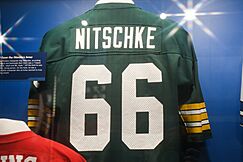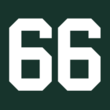Ray Nitschke facts for kids

circa 1966
|
|||||||
| No. 66 | |||||||
|---|---|---|---|---|---|---|---|
| Position: | Linebacker | ||||||
| Personal information | |||||||
| Born: | December 29, 1936 Elmwood Park, Illinois, U.S. |
||||||
| Died: | March 8, 1998 (aged 61) Venice, Florida, U.S. |
||||||
| Height: | 6 ft 3 in (1.91 m) | ||||||
| Weight: | 235 lb (107 kg) | ||||||
| Career information | |||||||
| High school: | Proviso Township (Maywood, Illinois) | ||||||
| College: | Illinois | ||||||
| NFL Draft: | 1958 / Round: 3 / Pick: 36 | ||||||
| Career history | |||||||
|
|||||||
| Career highlights and awards | |||||||
|
|||||||
| Career NFL statistics | |||||||
|
|||||||
|
Pro Football Hall of Fame
|
|||||||
Raymond Ernest Nitschke (born December 29, 1936 – died March 8, 1998) was an American football player. He played his entire 15-year career as a linebacker for the Green Bay Packers in the National Football League (NFL). He is famous for being a key player on defense for coach Vince Lombardi in the 1960s. Nitschke helped the Packers win five NFL championships and the first two Super Bowls. He was later honored in the Pro Football Hall of Fame in 1978.
Contents
Ray Nitschke's Early Life
Ray Nitschke was born in Elmwood Park, Illinois. He was the youngest of three sons. His father died in a car accident when Ray was only three years old. When Ray was 13, his mother passed away. His older brothers, Robert Jr. and Richard, decided to raise Ray themselves.
High School Football Star
Nitschke started at Proviso Township High School in Maywood. Losing both his parents made him feel a lot of anger. He sometimes got into fights with other kids. In his first year, he played fullback on one of the school's football teams.
Ray struggled with his schoolwork. His grades were not good enough, so he couldn't play sports in his second year. This made him feel very embarrassed. He worked hard to improve his grades. By his junior year, he was tall and strong. He became a star player on the varsity football team. He played quarterback on offense and safety on defense. He also played basketball and baseball. A professional baseball team, the St. Louis Browns, offered him money to play for them. But his coach told him to choose football. Ray wanted to play for a Big Ten university and hoped to play in the Rose Bowl. So, he accepted a football scholarship to the University of Illinois in 1954.
College Days at Illinois
Ray continued to struggle with his grades in college. In his second year (1955), the coach moved him from quarterback to fullback. This ended his dream of leading a team to a Rose Bowl win as a quarterback. Back then, players often played both offense and defense. On defense, Nitschke played linebacker. He was very good at tackling and became a skilled linebacker. By his senior year, some experts thought he was the best college linebacker.
In 1956, during a game against Ohio State, Nitschke lost four front teeth. He never wore a face mask. A helmet hit him in the mouth, knocking out two teeth. The other two were barely hanging on. But he kept playing the rest of the game!
Ray Nitschke's NFL Career
Ray grew up near Chicago and hoped to play for the Chicago Bears. But in the 1958 NFL draft, the Green Bay Packers chose him. He was picked in the third round (36th overall). This draft was very important for the Packers. Ray's first year in 1958 was tough. The team had a very bad record. Nitschke wore number 33 that year. For the rest of his career, he wore number 66.
A month after that tough season, Vince Lombardi became the new head coach. Nitschke became a full-time starter in 1962. He was a key player on a strong defense. This defense helped the Packers win five NFL titles and the first two Super Bowls in the 1960s.
Nitschke was named the Most Valuable Player (MVP) of the 1962 NFL Championship Game. He recovered two fumbles and tipped a pass that was intercepted. The Packers won the game 16–7. In Super Bowl I, Nitschke made six tackles and one sack. In Super Bowl II, he led the Packers' defense with nine tackles.
Ray was a starter until the 1970 season. In 1971, a new coach made him a reserve player. His last regular season game was in December 1972. The Packers won that game 30–20. They finished the season with a good record of 10–4. Green Bay made it to the playoffs that year. But they lost 16–3 to Washington in the first round. Nitschke came back for training camp in 1973. He then retired in late August.
Nitschke was known for his amazing strength and toughness. Before his third season in 1960, a heavy steel coaching tower fell on him during practice. Coach Lombardi heard what happened. When he learned it was Nitschke, he said, "He'll be fine. Get back to work!" A spike from the tower went into Nitschke's helmet, but he was not hurt. That helmet, with the hole, is now on display in the Packer Hall of Fame. Ray was famous for his hard hits. But he was also a great all-around linebacker. He intercepted 25 passes during his career.
Ray Nitschke's Personal Life
Ray Nitschke married Jackie Forchette on June 26, 1961. They could not have children, so they adopted three: John in 1963, Richard in 1966, and Amy in 1972. Ray and Jackie had a winter home in Naples, Florida. Coach Lombardi believed Jackie's calm personality helped Ray focus on his football career. Ray remained very popular in Green Bay after he retired. His phone number and home address were even listed in the Green Bay phone book.
In 1973, Ray Nitschke's autobiography was published. It was called Mean on Sunday: The Autobiography of Ray Nitschke.
In the late 1980s, Nitschke owned a car dealership in Green Bay. He made his own TV commercials. In these ads, he often brought out his dog, "Butkus." He named his dog after Dick Butkus, a famous player from the Chicago Bears who was his rival. Nitschke also appeared in a movie called Head with The Monkees. He played a football player who tackled Peter Tork. He also appeared in the 1974 football comedy The Longest Yard.
Ray Nitschke died of a heart attack in Venice, Florida in 1998. He was 61 years old. He was driving with his daughter, Amy, when he became ill. He passed away at Venice Hospital.
Honors and Legacy
The Green Bay Packers retired Ray Nitschke's number 66 in 1983. This means no other player on the team can wear that number. He was only the fourth player to have his number retired by the Packers. The team also named one of its outdoor practice fields "Ray Nitschke Field" in his honor.
In 1969, the NFL named him the best linebacker of all time for their 50th Anniversary. He is the only linebacker to be on both the NFL's 50th and 75th Anniversary Teams.
He was chosen for the Pro Football Hall of Fame in 1978. Every year, the Hall of Fame has a special lunch before the induction ceremony. Ray Nitschke always spoke at this lunch. He would tell the new inductees what a great honor it was to join the Hall of Fame. After he died, the Hall of Fame named the luncheon after him. He was also inducted into the Wisconsin Athletic Hall of Fame in 1981. He joined the Green Bay Packers Hall of Fame in 1978.
In 1999, The Sporting News ranked him number 18 on their list of the 100 Greatest Football Players. He was the highest-ranked player coached by Vince Lombardi.
The Ray Nitschke Memorial Bridge in Green Bay is named after him. It is a bridge over the Fox River. It was built in 1998 to replace an older bridge.




